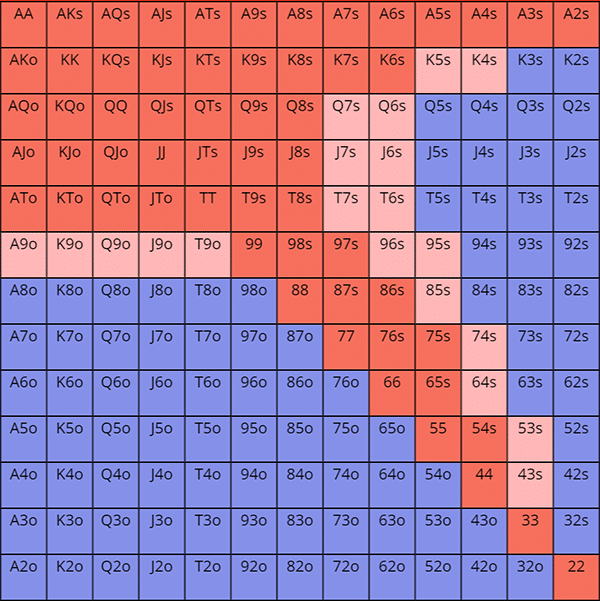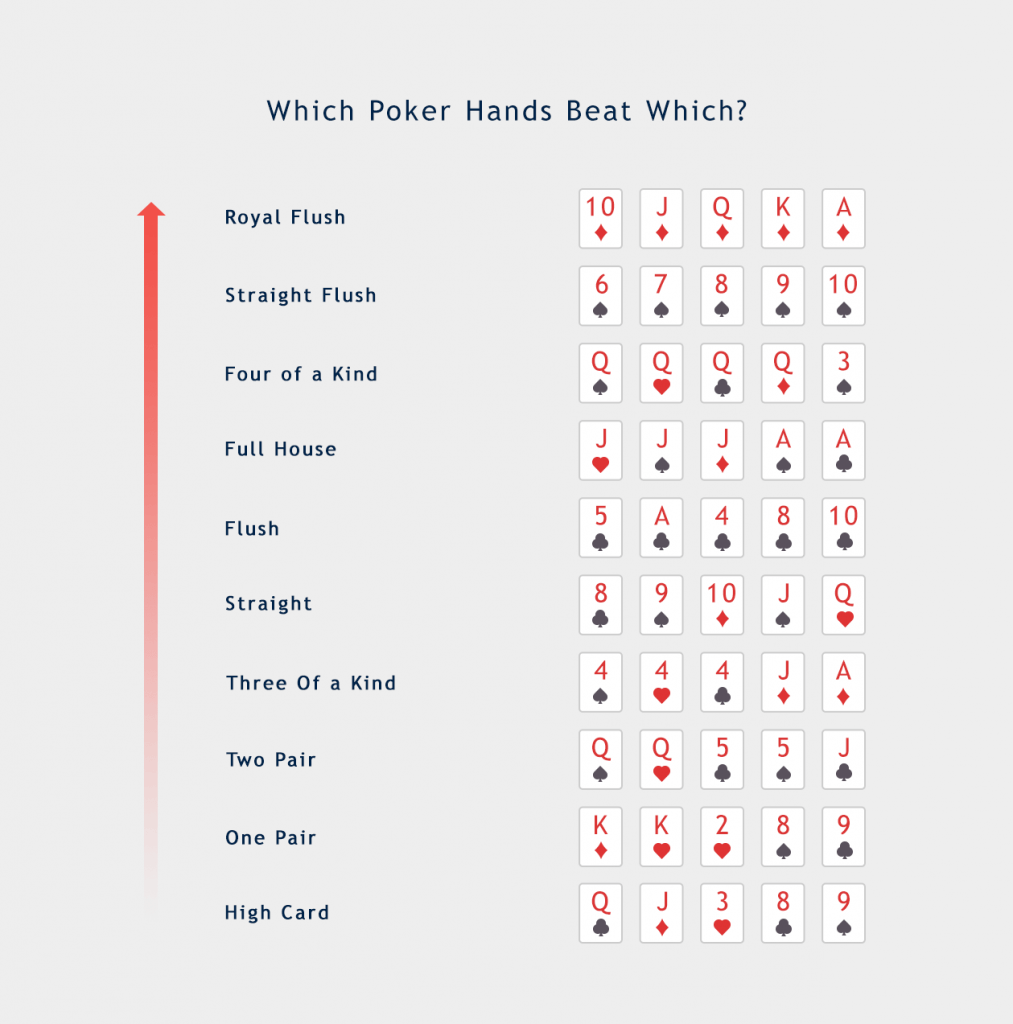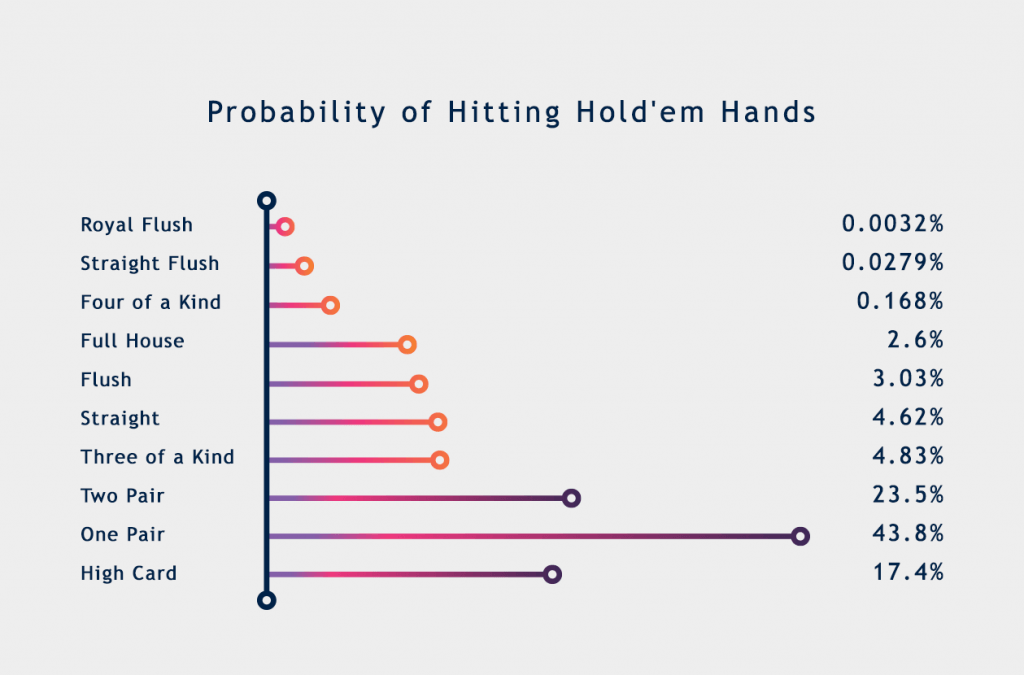Odds Poker Hands Texas Holdem
The table below shows the odds of each hand winning in typical all-in match ups in Texas Holdem. The percentage chance of winning assumes that both players are all-in and that all 5 community cards will be dealt to determine a winner. The table also assumes that there are no other players in the hand, although the results should be very similar.
- The Texas Holdem hands with the most playability are the hands that you’re confident of taking to the flop and into the later rounds. Virtually every other starting hand is a losing ticket. Playing weak starting hands is one of the worst ways to approach poker strategy. Focusing on extracting the maximum value from the best poker hands is the best way of maximising your poker odds! Tight Aggressive Style.
- Texas Holdem Heads-Up Preflop Odds. This table was created by enumerating through every possible board and opponent hole card combination for each of the 169 texas holdem preflop starting hands.
- Texas Holdem Odds and Outs. In the Poker variant known as Texas Hold ‘Em it’s very important to consider what the chances are of you improving your hand after the flop is dealt. If you have a poor starting hand, you will need to consider what cards can come on the turn & river, that could give you the best possible hand and more chances of winning.
- Calculating hand odds are your chances of making a hand in Texas Hold'em poker. For example: To calculate your hand odds in a Texas Hold'em game when you hold two hearts and there are two hearts on the flop, your hand odds for making a flush are about 2 to 1.
Every time you get dealt a hand in Texas Holdem your odds of getting pocket aces are 1/221, which is roughly 0.9%. First, let’s check how often do pocket aces win preflop. For better representation, I will take a sample of 100 examples. So next 100 times you receive an AA, 15 times you will lose and win 85 times.
All-in hands probability odds chart.

| Typical Match Up | Hand 1 | Hand 2 | ||
|---|---|---|---|---|
| Under Pair vs. Overcards | T T | 57% | 43% | A K |
| Overpair vs. Pair | K K | 80% | 20% | 9 9 |
| 2 Overcards vs. 2 Undercards | A Q | 63% | 37% | 5 7 |
| Dominated Hand | A J | 79% | 21% | J T |
| Very Dominated Hand | Q Q | 89% | 11% | Q J |
| Overcard vs. Dominated Kicker | A 9 | 29% | 71% | 9 9 |
| Pair vs. 1 Overcard | 8 8 | 69% | 31% | A 5 |
| 1 Overcard vs. 2 Middle Cards | J 4 | 57% | 43% | 6 8 |
How to use the all in match-ups odds chart.
The table can be used to estimate your chances of winning in common all-in situations, however, the table does not highlight the exact probabilities for the certain match-ups in general.
For example: in the pair v overcards match-up, 2 2 would be a 53% favorite against A K instead of being a slightly stronger favorite like T T with a 57% chance of winning. The is due to other factors such as the increased probability that two overpairs will appear on the board creating a higher two-pair with a better kicker for the player holding A K.
All in match up odds evaluation.
As you can see from the table, some of the match-ups are closer than you might expect them to be. For example, if you have another player dominated with a hand like A J against J T, your opponent will win the pot 1 time in 4. Therefore you should be careful not to become overly excited when cards like these are turned over in an all-in situation, because your opponent is not always as far behind as you think.
Another interesting all-in match up is the very common AK versus an under pair. The table shows that although the odds are fairly even, the under-pair will usually have the slight advantage.
This means that it is always better to be pushing all-in rather than calling an all-in with AK if necessary, because to call with AK against an under pair is a losing play in the long run. By pushing all-in with AK you give your opponent the opportunity to fold for fear of an overpair, which will improve your expectation in the long run.
Go back to the poker odds charts.
Can You Afford Not To Use
Poker Tracker 4?
“I wouldn’t play another session of online poker without it”
“I play $25NL, and in under 1 week PT4 had paid for itself”
Comments
Only starting out with poker in 2020?
I remember when I started with poker, I found remembering the important parts of the game challenging.
But your journey can become easier with this printable poker cheat sheet for beginners (I wish I had this when starting out!).

Table Of Contents
- How To Use This Texas Holdem Poker Cheat Sheet.
- How To Use This Pot Odds Cheat Sheet – Facing River Bet Example
- How To Use This Pot Odds Cheat Sheet – Facing Flop Bet Example
- Poker Hands Cheat Sheet: Best Texas Hold em Hands
Poker Cheat Sheet For Texas Holdem:
Download the high-quality Poker Cheat Sheet printable (PDF) version:
The cheat sheet includes hyperlinks for further reading on any material you may not yet know.
Click here for more information on pre-flop and post-flop. We also discuss Texas Holdem bet sizing in the highlighted link.
If you like the cheat sheet, you may also enjoy these these awesome starting hand charts from upswing poker. They are a more detailed version of the starting hands section in the cheat sheet above which supplement it nicely. Amazingly they have been downloaded almost 200,000 times!
How To Use This Texas Holdem Poker Cheat Sheet.
Step 1: Find your hand on the chart (example KT suited)
Step 2: Determine whether you should follow coloured or number schematic.
Either:
- If first to raise (no other player has raised before you), follow the coloured schematic.
- If facing a raise or reraise, follow the numbered schematic.

Note: If playing on a 6max table (6 players as opposed to 9), the yellow coloured hands will also be able to be played from any position.
See the image below for the numbered and colour schematic.
Step 3: Take into account information give under headings preflop and post flop.
How to play poker preflop is a tough subject to cover in detail. There are many factors you need to take into account such as:
- Your position and your opponents position.
- Your opponents likely holdings
- Board texture
- Previous history
A brief explanation of why position is powerful and why we play fewer hands when there are more players left to act (still with a hand):
When playing on a fullring table, you will have to contend with nine players, who each have a chance of picking up a big hand. Therefore, when playing a full ring game, you will play fewer hands. You can read more on this concept at fullring vs. 6max.
The difference in player numbers is also why we play a wide range of hands from the Button, but very few hands from UTG (first position). When opening the Button, we only have two players left to act (unlikely for them to have a strong hand), whereas when playing from UTG in a full ring game, eight other players could potentially pick up a big hand.
For more in-depth details on this see Texas Holdem Strategy and Position is King!
Step 4: Take home some cash
Hopefully, this poker cheat sheet will help you ‘bring home the bacon' as they say, but there is always something more to learn in poker. Keep reading for some more cheat sheets which might be of use to you.
Get Your Miniature (Credit Card Sized) Texas Holdem Starting Hands Cheat Sheet
This cheat sheet only contains the most vital information you need so it can handily fit in your pocket. The legends have also been squeezed onto the hand chart in front of hands we always fold.
To download printable PDF which is scaled to credit card size, use the Facebook unlock button:
Poker Odds Cheat Sheet (for Texas Hold'em)
Get your pot odds cheat sheet below. You can use this to determine the number of outs required to continue based on the pot odds you are being offered. You can also use it to convert between percentages, required outs and ratios for all kinds of situations in poker. The pot odds cheat sheet is explained in more detail below:
Click here to get a high-quality printable pdf version of the Poker Odds Cheat Sheet.
When your opponent bets you will be offered odds based on the size of his bet. For example, if your opponent bets half pot you will be offered odds of 3:1 on a call (call 1 to win 3). Essentially, it is your risk to reward ratio.
Pot odds will tell you whether is it correct for you to call or fold based on what size our opponent bet and how many cards that will improve our hand.
If you are interested in the learning poker math, check out our best poker books recommendation page here for some awesome books on poker math.
How To Use This Pot Odds Cheat Sheet – Facing River Bet Example
1. Work out pot odds
In this hand, our opponent bets $26 into a $41.5 pot making the total pot size $67.5. This gives us odds of 67.5: 26 (67.5 = 41.5+26). Or approximately 2.6:1. You can also see how to convert this into a percentage in our article pot odds.
2. Find 2.6:1 on the card (or as close to it as possible).
We locate 2.6:1 on the chart tells us that 2.6:1 translates to 30.11% pot equity. In other words:
- if we win 30% of the time, we will break even,
- if we win > 30% of the time we will make a profit on average in this situation
- if we win <30% of the time, we will make a loss on average in this situation
3. Determine our actual equity
This is the tough part, unfortunately.
You have to estimate how often you are beaten by your opponent in order to determine if you can profitably call or not. To do this you can use a program such as equilab to plug in hands that you think your opponent may have and the hand that you currently hold. To learn more about estimating what your opponent may be holding see the article poker hand range: the comprehensive beginner guide. From the example above, we plug in some hands we think our opponent may have and see that we have 34% equity:
4. Determine if we can profitably call.
Since our equity is greater than our pot odds, we can profitably call the river bet. If our equity were less than the pot odds being offered, we would have to fold as we cannot c call.
How To Use This Pot Odds Cheat Sheet – Facing Flop Bet Example
Let's take a similar situation (confronted with a bet), except this time we are on the flop with KQs, and we have a flush draw with nine outs. A King and Queen which could be considered outs, but they aren't clean outs. This means even if we hit our hand we still may not win (say for example our opponent has AA).
1. Work out equity percentage:
Since we have nine clean outs, we can simply go to the number 9 on the card and then determine our equity.
This means that we need a minimum pot odds of 1.9:1 or 38% when we have nine outs on the flop with two cards still to come.
3. Compare pot odds to odds given by bettor.
Our equity is 38%, so we need pot odds of less than 38%. The lower the pot odds, the more profitable the call.
Our pot odds are 12.5/33 which is 37%, and hence we just about have the pot odds to call. However, we are also in positon (and will act last with more information) and have two overcards to the board (both a King and Queen will make top pair good kicker). So this is an easy call.
4. Further reading
We need seven outs to continue, and we have nine outs with a flush draw. See calculating outs for more details.
For more information on how to use this poker cheat sheet see poker and pot odds.
This video will also be useful to you:
Poker Hands Cheat Sheet: Best Texas Hold em Hands
In case you aren't familiar with the hand strengths, and hand rankings of poker check out the printout Texas Holdem hands cheat sheet:
(You may also be interested in the rules of texas hold em)
There are a few important things to remember when memorising at the poker hand rankings:
Best Five Cards Win
In poker, it is always the best five cards wins. This means it is not only the pairs that matter if there is no clear winner (nobody has a pair), the decision will go down to high card wins.
Kickers
Kickers decide the winning hand when two opponents have the same pair or three of a kind. For example, if one opponent has AQ (ace-queen) and another has AJ, the opponent with AQ would win on an A7522 board as he has the five card hand of AAQ75 whereas the second opponent has AAJ75.
Split Pots
Odds Poker Hands Texas Holdemtexas Hold Em
Split pots occur when opponents have the same hand. For example, imagine one opponent has A4 and the other A3 on AQ752 board. Both opponents would have five card hand of AAQ75. Neither the 4 or 3 would play.
You can get more information about hand rankings on our web page here.
If you are more visually inclined, check out this video on poker hand rankings:
For more on Texas Hold'em strategy, see poker 101.
Probability Poker Hands Texas Hold Em
Make sure you check out the fan favourite posts:
Odds Of Texas Holdem Hands
Common poker mistakes & Texas Holdem Poker Tips
Good luck at the poker tables with your new poker cheat sheet!